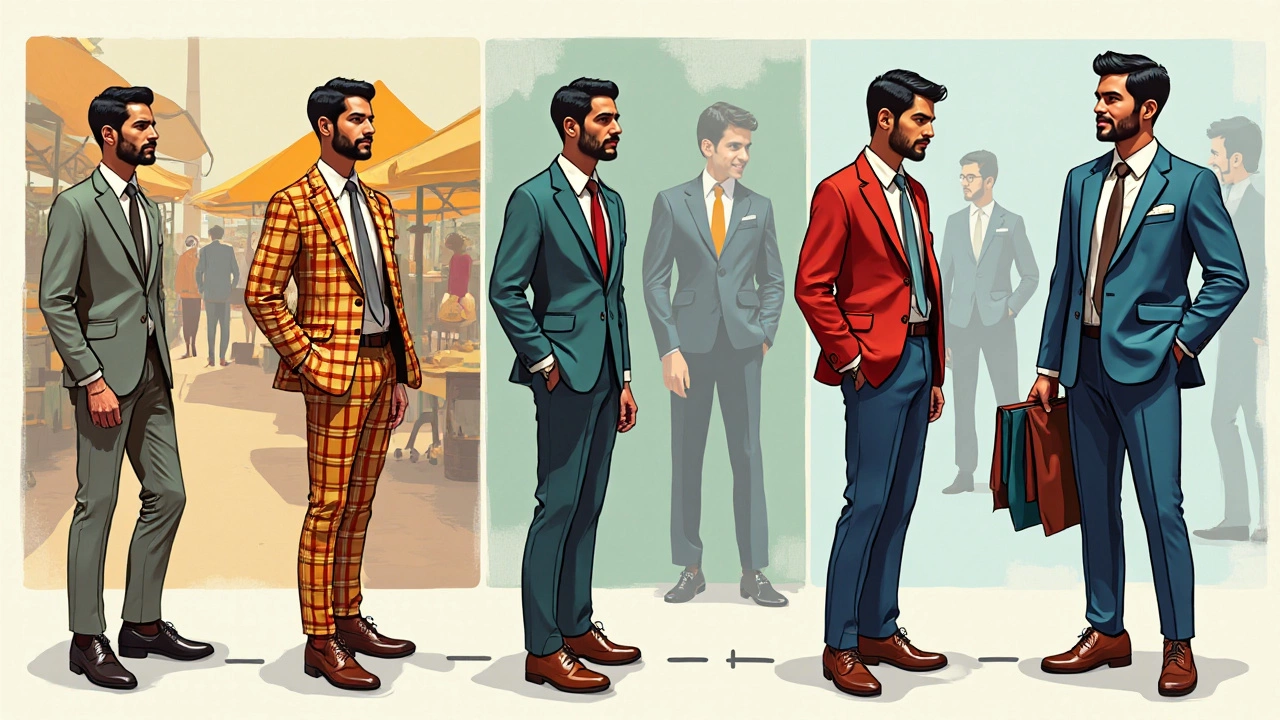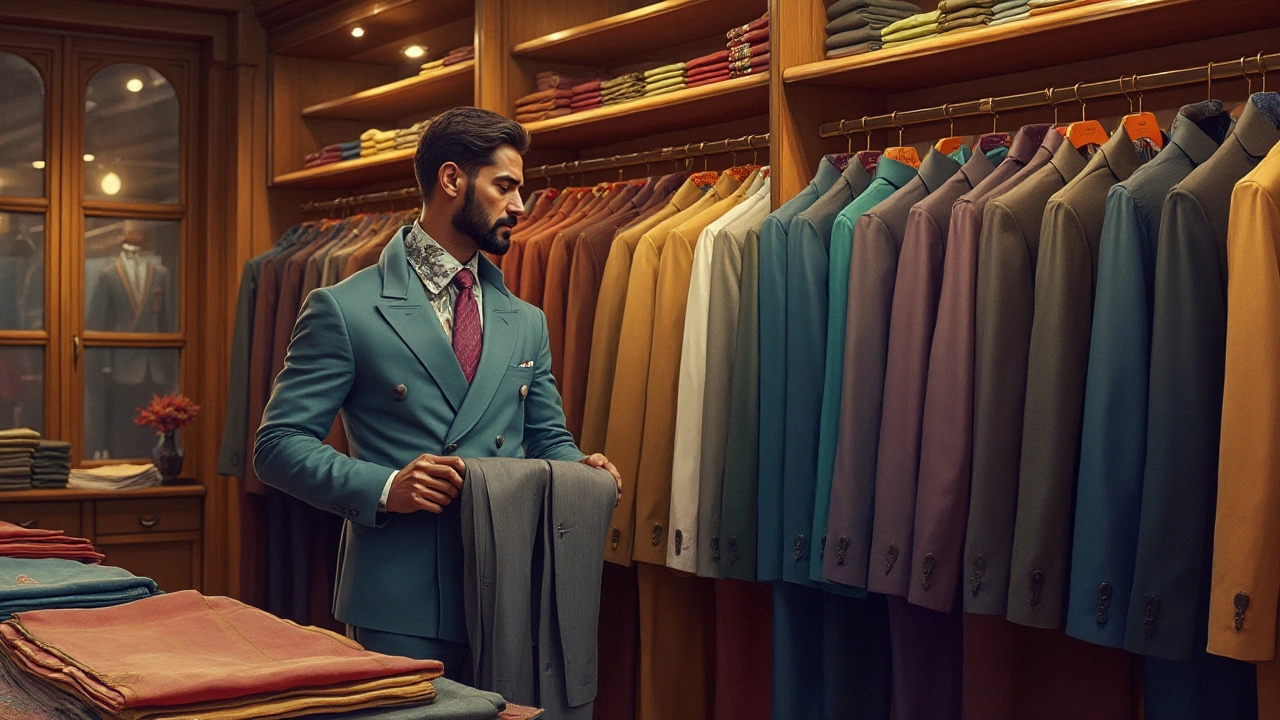When it comes to suiting up for special occasions or professional environments, the question of how much to spend on a suit often arises. While it may be tempting to go for the cheapest option, it's essential to consider that a suit is not just a piece of clothing, but an investment in one's personal and professional image.
Suits come in a spectrum of prices, each reflecting different levels of craftsmanship and materials. The key is to find the sweet spot where quality meets affordability, ensuring that you look sharp without breaking the bank. As we explore the factors that influence suit pricing, you’ll discover that sometimes spending a little more upfront can save you in the long run.
- Why Investing in a Suit Matters
- Understanding Suit Price Ranges
- Factors Affecting Suit Costs
- Evaluating Quality and Longevity
- Styles and Occasions: Dressing for Success
- Tips for Smart Suit Shopping
Why Investing in a Suit Matters
Investing in a men's suit is not merely about adhering to a dress code or conforming to societal norms; it is a reflection of one’s identity, character, and professionalism. A well-chosen suit has the potential to leave a lasting impression, be it at a job interview, a board meeting, or a social gathering. When you consider the world we live in, where first impressions greatly influence perceptions, dressing impeccably becomes key. A suit that fits well and complements your physique exudes confidence, signals attention to detail, and communicates that you are someone who values quality and respectability.
The craftsmanship behind a good suit contributes to the argument of why spending more should be seen as an investment rather than an expense. Fine suits often involve meticulous techniques passed down through generations in the tailoring industry. High-quality fabrics such as wool, cashmere, or silk not only ensure durability but also provide comfort and a perfect drape. As the saying goes, "a tailored suit makes an ordinary man extraordinary." This is echoed by designer Tom Ford:
"Dressing well is a form of good manners."This phrase captures the essence of how much your attire speaks on your behalf before words even leave your lips.
Another aspect to consider is the suit's cost-per-wear. While a suit from a fast-fashion brand might seem cheap, its short lifespan and susceptibility to wear and tear can quickly negate the initial savings. In contrast, investing in a suit of higher quality assures a better fit and durability, seamlessly standing the test of time. This translates to lower long-term costs and greater satisfaction with each wear. In terms of design and fit, a custom-made suit addresses unique body shapes and personal style, offering a level of precision that off-the-rack suits struggle to match. Such investment manifests itself in use cases that encompass both professional and personal scenarios.
Moreover, owning a suit that speaks volumes about you can enhance one's sartorial reputation. Histories are filled with iconic moments where leaders and influencers were distinguished by their impeccable styles. Tailoring not only adjusts the physical dimensions of the garment but also combines subtle details and personality with timeless elegance. Not to forget, the mental boost of wearing a tailored suit often translates to performance, quite literally dressing for success, leading to improved outcomes whether in negotiations, closing deals, or mere presence in competitive fields. Remember, dressing well is an art of communication, simplifying complex professional or interpersonal challenges.
Understanding Suit Price Ranges
When navigating through the sea of choices in men's fashion, knowing the price range of a suit can be quite beneficial. From budget-friendly options to high-end luxury splurges, each range offers different builds in terms of fabric, construction, fit, and style. Whether you're shopping on a shoestring for your first job interview or looking to make a statement with a designer piece, understanding these distinctions can help you make an informed choice.
For those starting out with a limited budget, suits in the under-$300 range can be a great introduction. These are widely available and generally machine-made, often with synthetic blends. Although they might not boast the fine detailing or the perfect drape of higher-end options, they serve an essential role for those requiring something sharp on a budget. However, as with many things in life, you get what you pay for. Entry-level suits might not hold up well to frequent use, both in physical durability and in terms of style trends, which can often make them a short-term solution rather than a lasting investment.
In the mid-range category, from $300 to $1000, the difference is markedly noticeable in the terms of quality and style. These suits often employ superior materials such as wool, which offers both breathability and a rich texture. Here, you'll often find half-canvassed construction, providing a better fit and silhouette than cheaper fused suits. As the price escalates within this range, so do the options for customization, with many retailers and brands offering made-to-measure services to ensure a perfect fit, elevating both your look and confidence substantially. The value-for-money metric is notably high here, especially if you're looking for everyday wear that's stylish and dependable. According to a survey by the Men's Clothing Manufacturers Association, the vast majority of consumers find the best compromise between quality and cost in this tier.
High-End (Over $1000)
"A well-tailored suit is to women what lingerie is to men." — Unknown
Over the $1000 mark, we enter the realm of bespoke tailoring and haute couture. Here, nothing is off-limits. These suits are crafted from the finest wool, cashmere, or even rare blends like vicuña, and feature full canvas construction for the ultimate drape and durability. At this level, every detail is meticulously considered—from hand-stitched lapels to exquisite linings and the ability to customize every aspect of your suit. Owning a suit in this bracket is not just about function; it's a statement of personal style and taste, often reserved for the sartorial enthusiast who appreciates the art of tailoring. These suits offer unparalleled longevity, often becoming heritage pieces passed down through generations.
Men's suits across different price points serve varying purposes and suit different lifestyles. The key is matching your investment to your needs, factoring in how often you'll wear it, the occasions it will serve, and your budget. By weighing up these metrics and understanding what you're getting in each range, finding the perfect suit becomes much less daunting and infinitely more rewarding.
Factors Affecting Suit Costs
One might wonder why there’s such a wide range in pricing when it comes to men's suits. The cost of a suit can be influenced by multiple factors, starting from the craftsmanship involved to the raw materials used. Understanding these components is crucial whether you're an experienced shopper or someone just entering the world of formal wear. First and foremost, the fabric used plays a significant role. Suits crafted from high-quality materials like pure wool, silk, or cashmere tend to be pricier due to their luxurious feel and durability. Cheaper fibers, on the other hand, such as polyester or blended fabrics, often lead to more economical options, but these might lack the comfort and elegance that natural fibers offer.
Another important dimension relates to the construction of the suit. Off-the-rack suits, which are mass-produced, generally cut down on costs significantly. Conversely, bespoke and made-to-measure suits, which are tailored specifically to fit, require skilled labor and more personal attention, thus increasing the price. But this isn't just about luxury; the tailored fit can make a remarkable difference in terms of comfort and appearance. Alongside fabric and fit, the brand name inevitably affects the cost. Reputable designers with a lineage of quality naturally charge more for their creations, reflecting not just the intricacy of their designs but also the prestige attached to wearing their label.
Additionally, the location of production impacts the cost of buying suits. Suits made in regions known for their tailoring excellence, like Italy or the UK, are often more expensive than those manufactured in countries with cheaper labor forces. For many, sustainability is another consideration. Eco-friendly production practices and ethical sourcing might come with higher price tags, encouraging environmentally conscious buyers to weigh their options carefully. Dr. Alan Montgomery, a seasoned fashion analyst, says,
"In the modern market, the price of a suit is not merely a reflection of its style but intertwines with the values of sustainability and social responsibility."For a curious mind, observing the trends in fashion and staying informed about these factors is sure to make any purchase a more informed one.

Evaluating Quality and Longevity
Choosing a suit goes beyond just finding the right color or cut; it's about investing in quality and ensuring that the piece will stand the test of time. The longevity of a suit primarily hinges on the fabric, construction, and care it receives. High-quality fabrics often lead to better comfort and durability, with wool being a popular choice due to its natural breathability and insulating properties. Wool suits cater to various occasions, thanks to their versatility and resilience. However, it's not just the material that speaks of a suit's quality but also the craftsmanship involved in putting it together. A well-made suit will exhibit meticulous attention to detail, including precise stitching and a flattering fit that follows the natural lines of your body.
The construction of a suit is another significant factor that impacts its quality and lifespan. A full or half-canvas construction is often indicative of higher quality, as these methods allow the suit to mold better to your shape over time, thereby enhancing comfort and appearance. On the flip side, fused suits, which are mass-produced with glued interlinings, may not conform as well to your body and tend to depreciate faster. They might be budget-friendly, but remember that they may not offer the same durability and aesthetic pleasure as their more carefully crafted counterparts.
To make a smart purchase, you should also pay attention to certain features, such as the buttonholes. Handmade buttonholes are often a hallmark of higher-quality suits. Additionally, checking for a perfect pattern match at the seams and plaid alignment helps indicate superior craftsmanship. Invest in a suit with reinforced stress points, as this feature extends its life, making it a worthwhile addition to your wardrobe. As Cary Grant once said,
"All it takes are a few simple outfits. And there's one secret - the simpler, the better."This simplicity often comes with higher standards of construction.
Once you've assessed a suit's quality based on material and construction, longevity then largely depends on how you care for it. Routine maintenance goes a long way; ensure your suits are regularly brushed to remove dust and aired out after each use to retain shape and freshness. Conservatively dry cleaning your suit, ideally twice a year, will maintain its integrity longer. Steam cleaning is another effective method to get rid of wrinkles without exposing the fabric to harsh chemicals. As the saying goes, a well-cared-for suit doesn't just dress a man; it defines him.
Styles and Occasions: Dressing for Success
Understanding different styles and occasions when selecting a men's suit is crucial to finding one that makes a lasting impression. Not all suits are created equal. From the way they drape on your shoulders to the sheen of the fabric in soft lighting, different styles speak to different settings. For formal occasions, consider a classic black or navy suit. These timeless pieces can handle a range of events, from weddings to evening galas, conveying a sophistication that's hard to surpass. They pair well with a crisp white shirt and the right tie, making you a standout.
On the other hand, for work settings or more casual occasions, you might opt for a grey or beige suit. Not only do these colors offer a more relaxed vibe, but they also allow for more flexibility when paired with a variety of shirts and accessories. In such contexts, the power lies in subtlety and the way you carry your ensemble. As Giorgio Armani once said,
"The difference between style and fashion is quality."It is all about understanding the nuances, like the number of buttons on the jacket, the lapel style, and the suit cut, which all influence how the suit will fit and flatter your body type.
Diving deeper, it's also worth noting that every piece within the suit budget you set adds a piece to the puzzle. The shirt you select can provide contrast or complement the dominant color of the suit, while the tie can give a playful or serious undertone, depending on its pattern and shade. Your choice of shoes, leather or suede, classic oxford or trendy loafers, completes the portrait you're painting. Personal touches, such as pocket squares, cufflinks, and tie clips, add polish and can even become conversation starters in the right circumstances.
When considering styles, it's wise to think about not just the present occasion but the suit's versatility for future events. One of the sage pieces of advice in men's fashion is to think about cost-per-wear. Spending a little more on a suit that can transition smoothly between different social arenas can often be more economical than purchasing several less expensive, single-purpose garments. In fashion, like in life, adaptability is key.
To help make an informed decision, let's explore some statistics. A recent survey noted that 60% of men feel more confident when wearing a suit compared to casual outfits. This confidence doesn't merely stem from the physical fit of the fabric but from what it represents—a commitment to presenting the best version of oneself. With that in mind, investing in a well-tailored suit becomes more than a fashion statement; it’s a declaration of intent.
Tips for Smart Suit Shopping
Shopping for a suit can be a delightful endeavor if you approach it with an informed mindset. First and foremost, setting a clear budget is crucial; it helps you navigate the vast market of men's suits without getting overwhelmed. A well-thought-out budget allows you to focus on quality rather than being swayed by flashy sales or brand names. It's wise to consider not just the initial expenditure but also the cost-per-wear; a more expensive, durable suit might offer better value over time compared to its cheaper, less resilient counterparts.
When it comes to fit, there's nothing quite as game-changing as having a suit that looks like it was made just for you. Investing in tailoring services can make a world of difference. Off-the-rack suits are handy, but they often require some adjustments, so factor alteration costs into your budget. A properly tailored suit accentuates your physique, boosting your confidence and image, and often gives the impression of a higher price point.
Fabric is another key consideration in your suit-buying journey. Wool is a perennial favorite due to its breathability and versatility across seasons. However, blends with synthetics or cotton might be lighter on the wallet and suitable for specific climates or settings. It's important to match the fabric choice with its intended use, whether for daily office wear or special occasions. Pay close attention to the lining as well; a quality lining improves the drape and comfort of the suit.
The seasonality and fashion trends of styles might be tempting to follow, but timeless designs usually offer greater versatility. Opt for classic colors like navy, gray, or charcoal, which adapt well to various settings and won't go out of style quickly. These basic shades offer a great foundation for building a versatile wardrobe. Adding a touch of personal flair is fine, perhaps with a unique tie or pocket square, allowing you to express individuality while maintaining a grounded, versatile look.
Always remember that renowned brands do not always equate to the best choice for every man. Reading reviews and seeking recommendations can greatly assist in making informed decisions. Finding that sweet spot where cost, comfort, and style harmoniously meet requires some legwork but pays dividends in the long run. As tailoring legend Giorgio Armani once said,
'The difference between style and fashion is quality.'In essence, focus on quality and what feels right, not merely what's trending.

